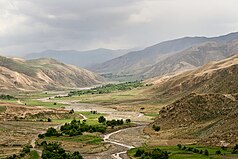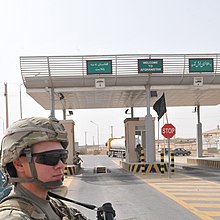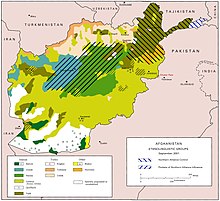Province in Afghanistan
| Kunduz قندوز | |
|---|---|
| Province | |
   From the top, Kunduz River Valley, Char Dara District, Afghanistan-Tajikistan Bridge From the top, Kunduz River Valley, Char Dara District, Afghanistan-Tajikistan Bridge | |
 Map of Afghanistan with Kunduz highlighted Map of Afghanistan with Kunduz highlighted | |
| Coordinates (Capital): 36°48′N 68°48′E / 36.8°N 68.8°E / 36.8; 68.8 | |
| Country | |
| Capital | Kunduz |
| Government | |
| • Governor | Vacant |
| • Deputy Governor | Habib-ur-Rehman Sohaib |
| • Police Chief | Azizullah |
| Area | |
| • Total | 8,040 km (3,100 sq mi) |
| Population | |
| • Total | 1,136,677 |
| • Density | 140/km (370/sq mi) |
| Time zone | UTC+4:30 (Afghanistan Time) |
| Postal code | 35xx |
| ISO 3166 code | AF-KDZ |
| Main languages | Pashto Dari Uzbek Turkmen |
Kunduz (Dari: قندوز) is one of the 34 provinces of Afghanistan, located in the northern part of the country next to Tajikistan. The population of the province is around 1,136,677, which is mostly a tribal society; it is one of Afghanistan's most ethnically diverse provinces with many different ethnicities in large numbers living there. The city of Kunduz serves as the capital of the province. It borders the provinces of Takhar, Baghlan, Samangan and Balkh, as well as the Khatlon Region of Tajikistan. The Kunduz Airport is located next to the provincial capital.
The Kunduz River valley dominates the Kunduz Province. The river flows irregularly from south to north into the Amu Darya river which forms the border between Afghanistan and Tajikistan. A newly constructed bridge crosses the Amu Darya at Sherkhan Bandar and the international trade is a large source of Kunduz's economy. The river, its tributaries, and derivative canals provide irrigation to the irrigated fields that dominate land usage in the agricultural province. There are also rain-fed fields and open range land that span several miles. Kunduz was once a major economic center for Afghanistan, but the wars since 1978 have changed fortunes for the province. Initially during the War in Afghanistan (2001-2021), Kunduz was one of the more stable regions of Afghanistan, but during the 2010s quickly turned into one of the most unstable provinces of the country, resulting in large parts falling under Taliban insurgent control. In 2021, the Taliban gained control of the province during their nationwide summer offensive.
History
Further information: History of AfghanistanThe area has been part of many empires in the past. It became part of the Afghan Durrani Empire in the mid-18th century. It saw a major migration from Russian Turkestan in the north during the early 1920s. During the governance of Sher Khan Nasher, Kunduz became one of the wealthiest of Afghanistan's provinces, mainly due to Nasher's founding of the Spinzar Cotton Company, which continues to exist in post-war Afghanistan in the early 20th century.
Between 100,000 and 200,000 Tajiks and Uzbeks fled the conquest of their homeland by Russian Red Army and settled in northern Afghanistan.
The province witnessed much violence and fighting during the Soviet–Afghan War.
During the war in Afghanistan Kunduz was captured by NATO forces. In November 2001, members of the Taliban and Al-Qaeda, along with Pakistani military personnel and Afghan sympathizers were airlifted to Pakistan to evade NATO capture in the Kunduz Airlift.

Germany had 4,000 soldiers stationed in the NATO-ISAF Kunduz province Provincial Reconstruction Team, along with Regional Command North. The province was largely peaceful until Taliban militants started infiltrating the area in 2009.
On 4 September 2009, the German commander called in an American jet fighter, which attacked two NATO fuel trucks, which had been captured by insurgents. More than 90 people died, among them at least 40 civilians, who had gathered to collect fuel.
Main articles: 2009 Kunduz airstrike and Kunduz Province CampaignIt was reported that on 21 November 2009, a bomb going off along the Takhar Kunduz highway killed a child and injured two others.
The governor, Mohammad Omar, was killed by a bomb on 8 October 2010.
On 10 February 2011, a suicide bomber killed a district governor and six other people in the district of Chardara in Kunduz Province, where the insurgency is well entrenched.
As part of the Taliban's resurgence in northern Afghanistan, Kunduz has been increasingly affected by war and instability. The Taliban after their ouster did not gain a foothold in Kunduz Province until 2009, but since then their influence expanded and they eventually captured the capital city of Kunduz briefly in 2015 and 2016. As of 2021, many parts are under Taliban control. Since the mid-2010s and in 2021 many residents have been forced to flee the province to places like Kabul or across the border to Tajikistan.
On 8 August 2021, the Taliban regained control of Kunduz City according to local sources.
Transportation
The province is served by Kunduz Airport which had regularly scheduled direct flights to Kabul as of May 2014. The Tajikistan–Afghanistan bridge at Panji Poyon connects the province to Tajikistan.
Economy
Agriculture and livestock husbandry are the primary occupations of the provinces residents. Fruit and vegetable are the most commonly farms items but there is also some cotton and sesame production. Farmers faced water shortages.
Men and women in Kunduz were employed in clothing production, metal working, carpentry and hide business.
The port of Sherkhan Bandar provides an international outlet for Kunduz's goods and has allowed for importing commercial goods from Asia, Middle East, and the Persian Gulf.
Cotton production is the province's most important industry. Agriculture is a significant source of income for 66 percent of households in the province, including 34 percent of urban households. However, commerce and services provide income to 28% of households, and non-farm work provides income to 15% of households. To some extent, Kunduz produces industrial crops. Sesame is another important product, in addition to cotton. The province's small-business sector is essentially non-existent, and karakul skin is the main product. Handicrafts aren't made in significant quantities, but rugs and jewelry are made to some extent. In the province, 85 percent of households have access to irrigated land, while 12 percent have access to irrigated land. Wheat, rice, watermelons, melons, and maize are among the province's most important field crops. Sheep, cattle, poultry, donkeys, and goats are the most frequent livestock.
Healthcare
The percentage of households with clean drinking water fell from 25% in 2005 to 16% in 2011. The percentage of births attended to by a skilled birth attendant increased from 6% in 2005 to 22% in 2011.
Infrastructure
Only 25% of families have access to safe drinking water, and only 18% of houses have access to electricity, with the bulk relying on public power. Safe toilets are found in only 2% of urban households, while they are almost non-existent in rural regions. The province's transportation infrastructure is fairly well developed, with 68 percent of roads capable of carrying car traffic in all seasons. However, there are no roads in 4% of the province. In terms of telecommunications, the Roshan (telco), Afghan Wireless, and MTN Digital phone networks are all operational in the province.
Education
The overall literacy rate (6+ years of age) fell from 33% in 2005 to 20% in 2011. The overall net enrolment rate (6–13 years of age) fell from 62% in 2005 to 50% in 2011.
Demographics
Further information: Demography of Afghanistan

Although a reliable census has not been carried out, as of 2020 the population of Kunduz province is estimated to be around 1,136,677 people. The province is mostly rural and very ethnically diverse of Afghanistan's provinces. According to the Naval Postgraduate School, the ethnic groups of the province are as follows: Pashtuns 33%, Uzbeks 27%, Tajiks 22%, Turkmens 11%, Hazaras 6%, and Pashais 1%.
About 94% of the population practice Sunni Islam and 6% are followers of Shia Islam. The major languages spoken in the area are Pashto, Dari Persian, and Uzbeki.
An estimated 49.3% of the population is female, with the other 50.7% being male.
| District | Capital | Population | Area | Pop. density |
Demographics |
|---|---|---|---|---|---|
| Ali Abad | 53,276 | 565 | 94 | 47% Pashtuns, 33% Tajiks, 12% Hazara, 8% Uzbeks | |
| Archi | 95,903 | 676 | 142 | 40% Pashtuns, 35% Uzbeks, 15% Tajiks, 10% Turkmen | |
| Chardara | 83,037 | 1,158 | 72 | 33% Uzbeks, 25% Tajiks, 22% Pashtuns, 17% Turkmen, 3% Hazara | |
| Imam Sahib | Sherkhan Bandar | 264,555 | 1,778 | 149 | 45% Uzbeks, 25% Pashtuns, 25% Tajiks, <1% Hazara Includes the Kalbaad District. |
| Khan Abad | 184,062 | 1,092 | 169 | 40% Pashtuns, 25% Tajiks, 20% Hazara, 10% Uzbeks, 5% Pashai Includes the Aqtash District. | |
| Kunduz | Kunduz | 376,232 | 612 | 615 | 33% Pashtuns, 27% Uzbeks, 22% Tajiks, 11% Turkmen, 6% Hazara, 1% Pashai Includes the Gul Tepah District. |
| Qalay-I-Zal | 79,612 | 1,984 | 40 | 90% Turkmen, 10% Pashtuns | |
| Kunduz | 1,136,677 | 8,081 | 141 | 33.2% Pashtuns, 26.8% Uzbeks, 21.8% Tajiks, 9.9% Turkmens, 6.1% Hazaras, 1.1% Pashayi. |
- Note: "Predominantely" or "dominated" is interpreted as 99%, "majority" as 70%, "mixed" as 1/(number of ethnicities), "minority" as 30% and "few" or "some" as 1%.
References
- ^ "د نږدې شلو ولایاتو لپاره نوي والیان او امنیې قوماندانان وټاکل شول". 7 November 2021. Archived from the original on 7 November 2021.
- ^ "Estimated Population of Afghanistan 2020-21" (PDF). Islamic Republic of Afghanistan, National Statistics and Information Authority. Archived from the original (PDF) on 3 July 2020. Retrieved 13 July 2022.
- ^ "Province: Kunduz" (PDF). Program for Culture & Conflict Studies. Naval Postgraduate School. Archived from the original (PDF) on 2 October 2012. Retrieved 17 January 2014.
- ^ Archived at Ghostarchive and the Wayback Machine: "Do you know why Kunduz is called 'Little Afghanistan". YouTube.
- ^ Benjamin Dubow (2009). "Ethnicity, Space, and Politics in Afghanistan" (Urban Studies Senior Seminar Papers). University of Pennsylvania, Urban Studies Program.
- ^ Gossman, Patricia (30 June 2020). ""You Have No Right to Complain": Education, Social Restrictions, and Justice in Taliban-Held Afghanistan". Human Rights Watch.
- ^ Wörmer, Nils (2012). "The Networks of Kunduz: A History of Conflict and Their Actors, from 1992 to 2001" (PDF). Stiftung Wissenschaft und Politik. Afghanistan Analysts Network. p. 8. Retrieved 7 September 2013.
According to The Liaison Office the ethnic composition of Kunduz province is as follows: 24 per cent Tajik 27 per cent Uzbek, 20 per cent Pashtun, , 9.4 per cent Turkmen, 4.6 per cent Arab, 23.5 per cent Hazara, plus a few very small groups including Baluch, Pashai and Nuristani.
- Bilal Sarwary (8 July 2001). "Taliban infiltrate once-peaceful Afghan north". BBC News. Retrieved 5 September 2009.
- Scores dead in Nato raid on Kunduz. Al Jazeera English, September 2009
- Nato air strike in Afghanistan kills scores – The Guardian, 4 September 2009
- "bombings kill 2 Afghan children", November 2009. Kabul, Xinhua news
- King, Laura (2 October 2011). "Afghanistan suicide bomber kills district governor, 6 others". Los Angeles Times. Retrieved 2 November 2011.
- "Taliban checkpoints are proliferating on Afghanistan's key roadways as foreign troops withdraw". The Washington Post. 30 April 2021.
- "Taliban captures three provincial capitals in lightning offensive". The Washington Times. 8 August 2021. Retrieved 8 August 2021.
- Kunduz UN, 2003 Archived 17 July 2013 at the Wayback Machine
- ^ Kunduz growers face irrigation water shortage, other pressing problems, By: Hidayatullah Hamdard ,Date: 2013-09-17, http://www.elections.pajhwok.com/en/content/kunduz-growers-face-irrigation-water-shortage-other-pressing-problems Archived 3 July 2017 at the Wayback Machine
- "Afghanistan Provincial Reconstruction Handbook": 87.
{{cite journal}}: Cite journal requires|journal=(help) - ^ Archive, Civil Military Fusion Centre, https://www.cimicweb.org/AfghanistanProvincialMap/Pages/Kunduz.aspx Archived 2 September 2013 at archive.today
- "Afghanistan Provincial Reconstruction Handbook": 98.
{{cite journal}}: Cite journal requires|journal=(help) - Masquelier, Adeline; Soares, Benjamin F. (15 June 2016). Muslim Youth and the 9/11 Generation. University of New Mexico Press. ISBN 9780826356994.
- "Estimated Population of Afghanistan 2021-22" (PDF). National Statistic and Information Authority (NSIA). April 2021. Archived from the original (PDF) on 24 June 2021. Retrieved 21 June 2021.
- "FAO in Afghanistan | Food and Agriculture Organization of the United Nations". www.fao.org.
- "Ethnic data taken from UNHCR Kunduz District Profiles on aims.org.af". Archived from the original on 31 May 2011. Retrieved 4 July 2009.
- Aliabad District, Kunduz Province. Afghan Biographies.
- https://web.archive.org/web/20070929111153/http://www.aims.org.af/afg/dist_profiles/unhcr_district_profiles/northern/kunduz/archi.pdf. Archived from the original (PDF) on 29 September 2007. Retrieved 11 August 2023.
{{cite web}}: Missing or empty|title=(help) - https://web.archive.org/web/20070929104521/http://www.aims.org.af/afg/dist_profiles/unhcr_district_profiles/northern/kunduz/iman_sahib/imam_sahib.pdf. Archived from the original (PDF) on 29 September 2007. Retrieved 11 August 2023.
{{cite web}}: Missing or empty|title=(help) - https://web.archive.org/web/20051027183031/http://www.aims.org.af/afg/dist_profiles/unhcr_district_profiles/northern/kunduz/khan_abad.pdf. Archived from the original (PDF) on 27 October 2005. Retrieved 11 August 2023.
{{cite web}}: Missing or empty|title=(help) - "Welcome - Program for Culture and Conflict Studies - Naval Postgraduate School" (PDF). Archived from the original (PDF) on 2 October 2012.
- https://web.archive.org/web/20051027185549/http://www.aims.org.af/afg/dist_profiles/unhcr_district_profiles/northern/kunduz/qalay_i_zal.pdf. Archived from the original (PDF) on 27 October 2005. Retrieved 11 August 2023.
{{cite web}}: Missing or empty|title=(help)
External links
| Places adjacent to Kunduz Province | ||||||||||||||||
|---|---|---|---|---|---|---|---|---|---|---|---|---|---|---|---|---|
| ||||||||||||||||
| Provinces of Afghanistan | ||
|---|---|---|
| Kunduz Province | ||
|---|---|---|
| Capital: Kunduz | ||
| Districts |  | |
| Populated Places | ||
| Other | ||
